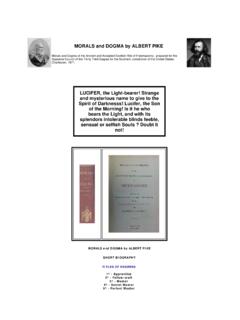Transcription of Saul Alinsky’s 12 Rules for Radicals
1 Saul alinsky s 12 Rules for Radicals Rules for Radicals (Random House 1971). alinsky dedicated his 12 Rules to lucifer , who he calls the original radical . lucifer is one of the names for Satan, the Devil, the Evil One and The Dragon (The Book of Revelations 12: 2; 20:2). See Hillary Rodham (Clinton) correspondence with alinsky on July 8, 1971 (attached). * RULE 1: Power is not only what you have, but what the enemy thinks you have. Power is derived from 2 main sources money and people. Have-Nots must build power from flesh and blood. (These are two things of which there is a plentiful supply. Government and corporations always have a difficult time appealing to people, and usually do so almost exclusively with economic arguments.)
2 * RULE 2: Never go outside the expertise of your people. It results in confusion, fear and retreat. Feeling secure adds to the backbone of anyone. (Organizations under attack wonder why Radicals don t address the real issues. This is why. They avoid things with which they have no knowledge.) * RULE 3: Whenever possible, go outside the expertise of the enemy. Look for ways to increase insecurity, anxiety and uncertainty. (This happens all the time. Watch how many organizations under attack are blind-sided by seemingly irrelevant arguments that they are then forced to address.) Saul alinsky s 12 Rules for Radicals -2- * RULE 4: Make the enemy live up to its own book of Rules .
3 If the rule is that every letter gets a reply, send 30,000 letters. You can kill them with this because no one can possibly obey all of their own Rules . (This is a serious rule. The besieged entity s very credibility and reputation is at stake, because if activists catch it lying or not living up to its commitments, they can continue to chip away at the damage.) * RULE 5: Ridicule is man s most potent weapon. There is no defense. It s irrational. It s infuriating. It also works as a key pressure point to force the enemy into concessions. (Pretty crude, rude and mean, huh? They want to create anger and fear.) * RULE 6: A good tactic is one your people enjoy. They ll keep doing it without urging and come back to do more.
4 They re doing their thing, and will even suggest better ones. ( radical activists, in this sense, are no different that any other human being. We all avoid un-fun activities, and but we revel at and enjoy the ones that work and bring results.) * RULE 7: A tactic that drags on too long becomes a drag. Don t become old news. (Even radical activists get bored. So to keep them excited and involved, organizers are constantly coming up with new tactics.) * RULE 8: Keep the pressure on. Never let up. Keep trying new things to keep the opposition off balance. As the opposition masters one approach, hit them from the flank with something new. (Attack, attack, attack from all sides, never giving the reeling organization a chance to rest, regroup, recover and re-strategize.)
5 * RULE 9: The threat is usually more terrifying than the thing itself. Imagination and ego can dream up many more consequences than any activist. (Perception is reality. Large Saul alinsky s 12 Rules for Radicals -3- organizations always prepare a worst-case scenario, something that may be furthest from the activists minds. The upshot is that the organization will expend enormous time and energy, creating in its own collective mind the direst of conclusions. The possibilities can easily poison the mind and result in demoralization.) * RULE 10: If you push a negative hard enough, it will push through and become a positive. Violence from the other side can win the public to your side because the public sympathizes with the underdog.
6 (Unions used this tactic. Peaceful [albeit loud] demonstrations during the heyday of unions in the early to mid-20th Century incurred management s wrath, often in the form of violence that eventually brought public sympathy to their side.) * RULE 11: The price of a successful attack is a constructive alternative. Never let the enemy score points because you re caught without a solution to the problem. (Old saw: If you re not part of the solution, you re part of the problem. Activist organizations have an agenda, and their strategy is to hold a place at the table, to be given a forum to wield their power. So, they have to have a compromise solution.) * RULE 12: Pick the target, freeze it, personalize it, and polarize it.
7 Cut off the support network and isolate the target from sympathy. Go after people and not institutions; people hurt faster than institutions. (This is cruel, but very effective. Direct, personalized criticism and ridicule works.) Saul alinsky s 12 Rules for Radicals -4- alinsky s Rules for Radicals One Pager "Tactics are those conscious deliberate acts by which human beings live with each other and deal with the world around them.. Here our concern is with the tactic of taking; how the Have-Nots can take power away from the Haves." Always remember the first rule of power tactics ( ): 1. "Power is not only what you have, but what the enemy thinks you have." 2. "Never go outside the expertise of your people.
8 When an action or tactic is outside the experience of the people, the result is confusion, fear and [and] the collapse of communication. 3. "Whenever possible, go outside the expertise of the enemy. Look for ways to increase insecurity, anxiety and uncertainty. (This happens all the time. Watch how many organizations under attack are blind-sided by seemingly irrelevant arguments that they are then forced to address.) 4. "Make the enemy live up to its own book of Rules . You can kill them with this, for they can no more obey their own Rules than the Christian church can live up to Christianity." 5. "Ridicule is man's most potent weapon. It is almost impossible to counteract ridicule.
9 Also it infuriates the opposition, which then reacts to your advantage." 6. "A good tactic is one your people enjoy." 7. "A tactic that drags on too long becomes a drag. Man can sustain militant interest in any issue for only a limited " 8. "Keep the pressure on, with different tactics and actions, and utilize all events of the period for your purpose." 9. "The threat is usually more terrifying than the thing itself." 10. "If you push a negative hard and deep enough, it will break through into its every positive has its negative." The major premise for tactics is the development of operations that will maintain a constant pressure upon the opposition. It is this unceasing pressure that results in the reactions from the opposition that are essential for the success of the campaign.
10 " 11. "The price of a successful attack is a constructive alternative." 12. Pick the target, freeze it, personalize it, and polarize it. In conflict tactics there are certain Rules that [should be regarded] as universalities. One is that the opposition must be singled out as the target and 'frozen.'.. "..any target can always say, 'Why do you center on me when there are others to blame as well?' When your 'freeze the target,' you disregard these [rational but distracting] Then, as you zero in and freeze your target and carry out your attack, all the 'others' come out of the woodwork very soon. They become visible by their support of the ' "One acts decisively only in the conviction that all the angels are on one side and all the devils on the other.







